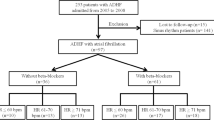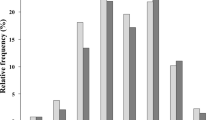Abstract
Introduction
Prognostic significance of heart rate (HR) in heart failure with preserved ejection fraction (HFpEF) remains poorly understood.
Aim
To evaluate the association of HR and beta-blocker use with all-cause mortality and the optimal HR range in patients with HFpEF and sinus rhythm (SR).
Methods
During a follow-up of 2.7 years (IQR 1.2–4.1 years), the 330 patients with median age 73 (IQR 64–79) years, 52.1% men, were included. HFpEF was defined as patients with EF ≥ 50%. The outcome measure was all-cause mortality.
Results
In total, 96 (29.1%) of patients with HFpEF and SR died. A linear tendency between HR and mortality was observed in SR. Compared to the reference strata HR ≤ 60 bpm, HR increment was associated with progressively increased risk in mortality (Chi-square = 13.90, Log rank P = 0.001) by Kaplan–Meier analyses. Univariate Cox regression showed that in SR, compared with that in HR 61–80 bpm, the unadjusted hazard ratios for mortality were 0.41 (95% CI 0.23–0.74, P = 0.003) in HR ≤ 60 bpm, 1.38 (95% CI 0.85–2.24, P = 0.189) in HR > 80 bpm. Multivariate Cox regression showed that compared with that in HR 61–80 bpm, the adjusted hazard ratios for mortality were 0.37 (95% CI 0.19–0.75, P = 0.005) in HR ≤ 60 bpm, 0.96 (95% CI 0.52–1.74, P = 0.899) in HR > 80 bpm. Univariate Cox regression showed that the unadjusted hazard ratios for mortality were 0.52 (95% CI 0.33–0.84, P = 0.003) in patients with beta-blocker as compared patients without beta-blocker. Multivariate Cox regression showed that the adjusted hazard ratios for mortality were 0.48 (95% CI 0.26–0.87, P = 0.016) in patients with beta-blocker as compared patients without beta-blocker.
Conclusions
HR is independently associated with increased all-cause mortality in SR and a lower HR (≤ 60 bpm) is favorable for better outcome in HFpEF patients with SR. Beta-blocker use is associated with reduced mortality and a lower HR is associated with reduced mortality in HFpEF patients with SR.



Similar content being viewed by others
References
Owan TE, Hodge DO, Herges RM, Jacobsen SJ, Roger VL, Redfield MM. Trends in prevalence and outcome of heart failure with preserved ejection fraction. N Engl J Med. 2006;355(3):251–9 (PubMed: 16855265).
Bhatia RS, Tu JV, Lee DS, Austin PC, Fang J, Haouzi A, et al. Outcome of heart failure with preserved ejection fraction in a population-based study. N Engl J Med. 2006;355(3):260–9 (PubMed: 16855266).
Böhm M, Swedberg K, Komajda M, Borer JS, Ford I, Dubost-Brama A, et al. Heart rate as a risk factor in chronic heart failure (SHIFT): the association between heart rate and outcomes in a randomised placebo-controlled trial. Lancet. 2010;376(9744):886–94 (PubMed: 20801495).
Pocock SJ, Wang D, Pfeffer MA, Yusuf S, McMurray JJ, Swedberg KB, et al. Predictors of mortality and morbidity inpatients with chronic heart failure. Eur Heart J. 2006;27(1):65–75 (PubMed: 16219658).
Cullington D, Goode KM, Zhang J, Cleland JG, Clark AL. Is heart rate important for patients with heart failure in atrial fibrillation? J ACC Heart Fail. 2014;2(3):213–20 (PubMed: 24952686).
Vasan RS, Benjamin EJ, Levy D. Prevalence, clinical features and prognosisof diastolic heart failure: an epidemiologic perspective. J Am Coll Cardiol. 1995;26(7):1565–74 (PubMed: 7594087).
Lenzen MJ, Scholte op Reimer WJ, Boersma E, Vantrimpont PJ, Follath F, Swedberg K, et al. Differences between patients with a preserved anda depressed left ventricular function: a report from the EuroHeart Failure Survey. Eur Heart J. 2004;25(14):1214–20 (PubMed: 15246639).
Lund LH, Donal E, Oger E, Hage C, Persson H, Haugen-Löfman I, et al. Association between cardiovascular vs. non-cardiovascular co-morbidities and outcomes in heart failure with preserved ejection fraction. Eur J Heart Fail. 2014;16(9):992–1001 (PubMed: 25046483).
Zabarovskaja S, Hage C, Linde C, Daubert JC, Donal E, Gabrielsen A, et al. Adaptive cardiovascular hormones in a spectrum of heart failure phenotypes. Int J Cardiol. 2015;189:6–11 (PubMed: 25885866).
Hogg K, McMurray J. Neurohumoral pathways in heart failure with preserved systolic function. Prog Cardiovasc Dis. 2005;47(6):357–66 (PubMed: 16115515).
Böhm M, Perez AC, Jhund PS, Reil JC, Komajda M, Zile MR, et al. Relationship between heart rate and mortality and morbidity in the irbesartan patients with heart failure and preserved systolic function trial (I-Preserve). Eur J Heart Fail. 2014;16(7):778–87 (PubMed: 24864045).
Masoudi FA, Havranek EP, Smith G, Fish RH, Steiner JF, Ordin DL, et al. Gender, age and heart failure with preserved left ventricular systolic function. J Am Coll Cardiol. 2003;41(2):217–23 (PubMed: 12535812).
Berry C, Hogg K, Norrie J, Stevenson K, Brett M, McMurray J. Heart failure with preserved left ventricular systolic function: a hospital cohort study. Heart. 2005;91(7):907–13 (PubMed: 15958359).
Roy D, Talajic M, Dorian P, Connolly S, Eisenberg MJ, Green M, et al. Amiodarone to prevent recurrence of atrial fibrillation. Canadian Trial of Atrial Fibrillation Investigators. N Engl J Med. 2000;342(13):913–20 (PubMed: 10738049).
Ahmed S, Rienstra M, Crijns HJ, Links TP, Wiesfeld AC, Hillege HL, et al. Continuous vs episodic prophylactic treatment with amiodarone for the prevention of atrial fibrillation: a randomized trial. JAMA. 2008;300(15):1784–92 (PubMed: 18854540).
Roy D, Talajic M, Nattel S, Wyse DG, Dorian P, Lee KL, et al. Rhythm control versus rate control for atrial fibrillation and heart failure. N Engl J Med. 2008;358(25):2667–77 (PubMed: 18565859).
Kong MH, Shaw LK, O’Connor C, Califf RM, Blazing MA, Al-Khatib SM. Is rhythm-control superior to rate-control in patients with atrial fibrillation and diastolic heart failure? Ann Noninvasive Electrocardiol. 2010;15(3):209–17 (PubMed: 20645962).
Mulder BA, Van Veldhuisen DJ, Crijns HJ, Tijssen JG, Hillege HL, Alings M, et al. Lenient vs. strict rate control in patients with atrial fibrillation and heart failure: a post-hoc analysis of the RACE II study. Eur J Heart Fail. 2013;15(11):1311–8 (PubMed: 23759284).
Castagno D, Skali H, Takeuchi M, Swedberg K, Yusuf S, Granger CB, et al. Association of heart rate and outcomes in a broad spectrum of patients with chronic heart failure: results from the CHARM (Candesartan in Heart Failure: Assessment of Reduction in Mortality and morbidity) program. J Am Coll Cardiol. 2012;59(20):1785–95 (PubMed: 22575317).
Triposkiadis F, Karayannis G, Giamouzis G, Skoularigis J, Louridas G, Butler J. The sympathetic nervous system in heart failure: physiology, pathophysiology; and clinical implications. J Am Coll Cardiol. 2009;54(19):1747–62 (PubMed: 19874988).
Brunner-La Rocca HP, Esler MD, Jennings GL, Kaye DM. Effect of cardiac sympathetic nervous activity on mode of death in congestive heart failure. Eur Heart J. 2001;22(13):1136–43 (PubMed: 11428854).
Grassi G, Seravalle G, Quarti-Trevano F, Dell’Oro R, Arenare F, Spaziani D, et al. Sympathetic and baroreflex cardiovascular control in hypertension-related left ventricular dysfunction. Hypertension. 2009;53(2):205–9 (PubMed: 19124679).
Oliva F, Sormani P, Contri R, Campana C, Carubelli V, Cirò A, et al. Heart rate as a prognostic marker and therapeutic target in acute and chronic heart failure. Int J Cardiol. 2018;253:97–104 (PubMed: 29249470).
Sartipy U, Savarese G, Dahlström U, Fu M, Lund LH. Association of heart rate with mortality in sinus rhythm and atrial fibrillation in heart failure with preserved ejection fraction. Eur J Heart Fail. 2019. https://doi.org/10.1002/ejhf.1389 (epub ahead of print).
MERIT-HF Study Group. Effect of metoprolol CR/XL in chronic heart failure: Metoprolol CR/XL randomised intervention trial in congestive heart failure (MERIT-HF). Lancet. 1999;353:2001–7 (PubMed: 10376614).
CIBIS II Investigators and Committees. The Cardiac Insufficiency Bisoprolol Study II (CIBIS-II): a randomized trial. Lancet. 1999;353:9–13 (PubMed: 10023943).
Martin N, Manoharan K, Thomas J, Davies C, Lumbers RT. Beta-blockers and inhibitors of the renin-angiotensin aldosterone system for chronic heart failure with preserved ejection fraction. Cochrane Database Syst Rev. 2018;6:CD012721 (PubMed: 29952095).
Yancy CW, Jessup M, Bozkurt B, Butler J, Casey DE Jr, Drazner MH, et al. 2013 ACCF/AHA guideline for the management of heart failure: a report of the American College of Cardiology Foundation/American Heart Association Task Force on Practice Guidelines. J Am Coll Cardiol. 2013;62(16):e147–239 (PubMed: 23747642).
Rienstra M, Damman K, Mulder BA, Van Gelder IC, McMurray JJ, Van Veldhuisen DJ. Beta-blockers and outcome in heart failure and atrial fibrillation: a meta-analysis. JACC Heart Fail. 2013;1(1):21–8 (PubMed: 24621795).
Li SJ, Sartipy U, Lund LH, Dahlström U, Adiels M, Petzold M, et al. Prognostic significance of resting heart rate and use of β-blockers in atrial fibrillation and sinus rhythm in patients with heart failure and reduced ejection fraction: findings from the Swedish Heart Failure Registry. Circ Heart Fail. 2015;8(5):871–9 (PubMed: 26243796).
Acknowledgements
The study was supported by the National Natural Science Foundation of China (NSFC) (No: 81570384). The authors gratefully acknowledge the participation of the patients and the contribution of the investigators.
Author information
Authors and Affiliations
Corresponding author
Ethics declarations
Conflict of interest
There are no conflicts of interest.
Ethical approval
This study was approved by the Human Subjects Review Committee at Chinese People’s Liberation Army General Hospital in Beijing, China.
Informed consent
Individual patient consent was not required, but patients were informed of entry into the study.
Rights and permissions
About this article
Cite this article
Li, S., Li, X. Prognostic Significance of Heart Rate and Beta-Blocker Use in Sinus Rhythm in Patients with Heart Failure and Preserved Ejection Fraction. High Blood Press Cardiovasc Prev 26, 405–411 (2019). https://doi.org/10.1007/s40292-019-00341-5
Received:
Accepted:
Published:
Issue Date:
DOI: https://doi.org/10.1007/s40292-019-00341-5




